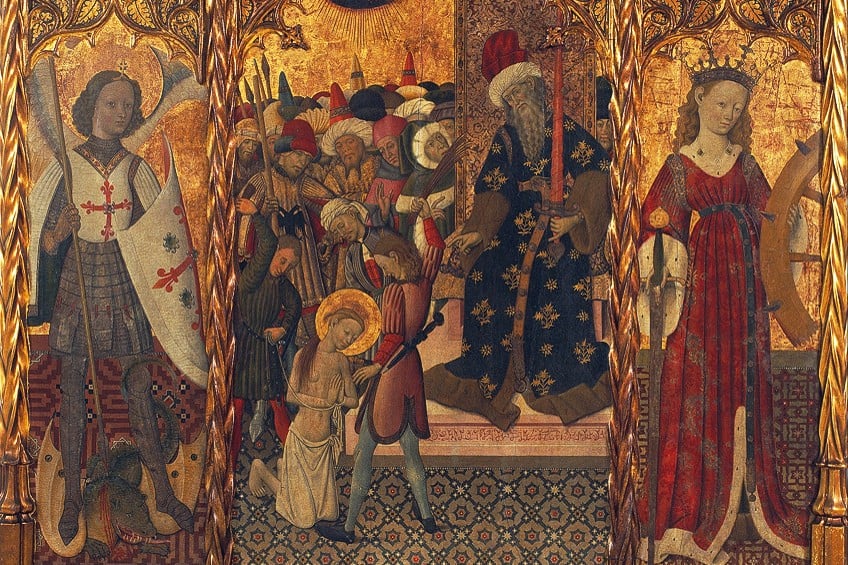Famous Gothic Paintings – Explore the Top Gothic-Period Art
In the 12th century AD, Gothic artwork, a kind of Medieval art, emerged in Northern France and evolved out of Romanesque art. There was a lot more secular Goth art than many people realize because religious art typically has a higher chance of preservation than its secular counterparts, however, a substantial percentage of the artwork created during this time was religious, whether it was paid for by the church or by the common people. Famous Gothic artworks frequently included a typological theme, reflecting the idea that the Old Testament’s events foreshadowed the New and that this was, in fact, its fundamental value. This article will explore the famous Gothic paintings and Goth drawings that perfectly embody Gothic-period art.
Famous Gothic Paintings
Painting in the Gothic style did not exist until around the year 1200, over 50 years after the birth of Gothic sculpture and architecture. The shift from Romanesque to Gothic is hazy and not often obvious, and Gothic decorative details were frequently incorporated before considerable change later becomes evident in the design of figures or compositions of Gothic artworks. Then Gothic artists began to depict characters that were more dynamic in attitude and facial expressions, were smaller in comparison to the background environment of scenes, and were also grouped more loosely in the picture plane where there is space.
Here is a select list of famous Gothic paintings that stand out from the era of Gothic-period art.
The Rucellai Madonna (1285) by Duccio di Buoninsegna
| Artist | Duccio di Buoninsegna (1255 – 1319) |
| Date | 1285 |
| Medium | Tempera and gold on panel |
| Location | Uffizi Gallery, Florence, Italy |
This famous Gothic painting is the earlier of Duccio’s two paintings for which verifiable documentation exists. The lay confraternity dedicated to the Virgin acquired the altarpiece to adorn the chapel they inhabited in the transept of the Dominican church of Santa Maria Novella in Florence, which had just been completed. A skilled carpenter would have built the frame and panel before handing it over to Duccio to paint.
The painting’s symbolism was determined by the demands of the benefactors and the Dominican order.
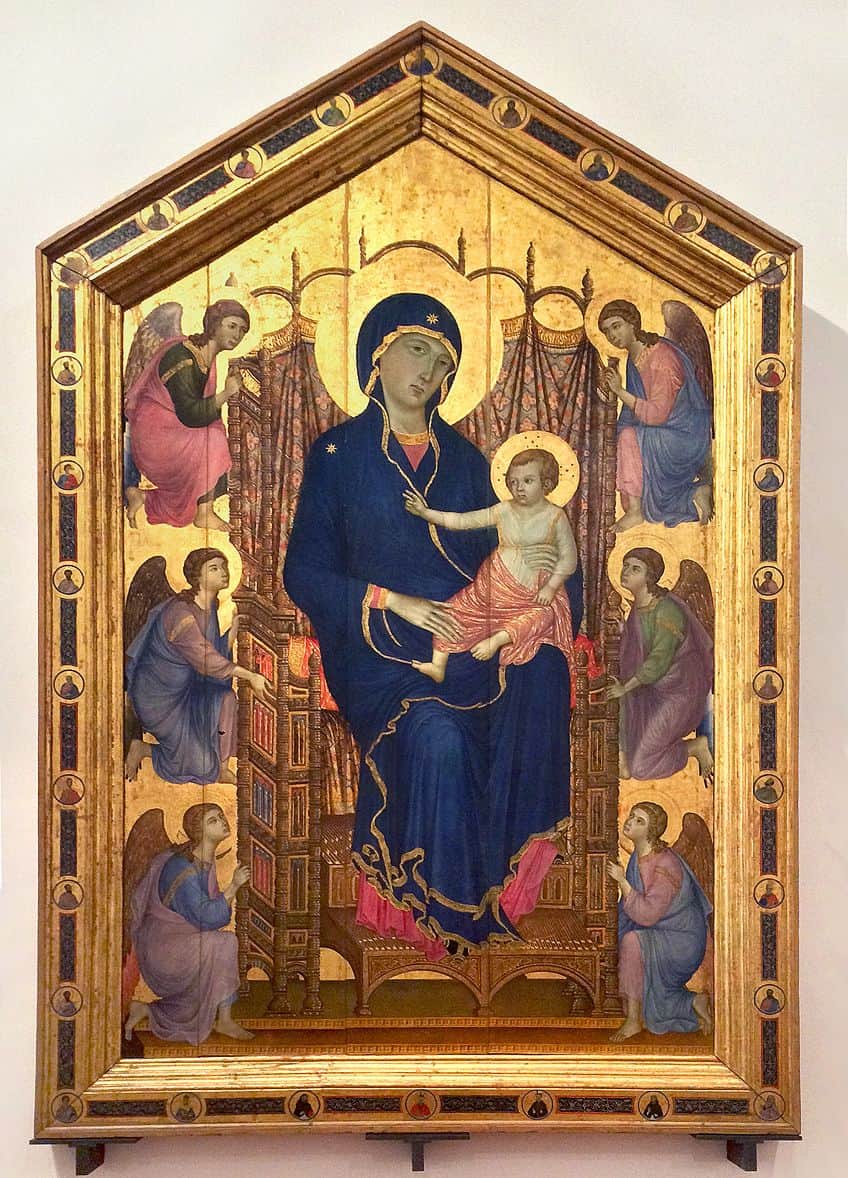
The Laudesi gathered at the church to recite Latin songs worshiping the Virgin; a figure of Mary served as a focal point for their devotions. The frame depicts saints, apostles, and important Dominican order leaders, including Saints Thomas Aquinas and Dominic. The two figures are seated on a golden background, encircled by angels, in this famous Gothic artwork.
In the 19th century, this famous Goth artwork was moved to the Galleria Degli Uffizi.
Ognissanti Madonna (1306) by Giotto di Bondone
| Artist | Giotto di Bondone (1267 – 1337) |
| Date | 1306 |
| Medium | Tempera |
| Location | Uffizi Gallery, Florence, Italy |
Even though it is undocumented, this altarpiece is the sole panel work by Giotto that is widely acknowledged by experts. It was created for the Ognissanti church in Florence, which was erected by the Humiliati, an unknown religious order.
It is a big artwork, and experts disagree whether it was intended for the church’s main altar, where it would only have been visible exclusively by the order’s brothers, or perhaps for the choir screen, where it could have been conveniently seen by the public at large.

The shimmering gravitas of the painting captivates us from the moment we gaze at the renowned Goth artwork. The golden color of the backdrop is blended with the depiction as a whole by a delicate web of golden decorative stitching on the robes, halos, and ornamental embellishments. The delicate tones of violets and pinks, the warm reds and greens, and the flesh colors of the characters all take on a magnificent brilliance as a result, allowing the image to shine with unparalleled radiance.
This famous Gothic artwork, with its new vision of the topic and delicate manner of painting woven through with gold, ranks among Giotto’s panel painting high points.
Guidoriccio da Fogliano at the Siege of Montemassi (1330) by Simone Martini
| Artist | Simone Martini (1284 – 1344) |
| Date | 1330 |
| Medium | Fresco |
| Location | Palazzo Publico, Siena, Italy |
This Gothic painting depicts Guidoriccio da Fogliano, the leader of the Sienese forces, on horseback against a scene depicting the siege of Montemassi. For a long period, it was supposed that Simone Martini produced the piece in 1330. Because of this, it is considered one of the earliest examples of secular portraiture and one of the first massive landscape artworks.
It is widely regarded as a European painting masterpiece. In 1977, a heated controversy sprang out among art historians over whether Martini was, in fact, the creator.
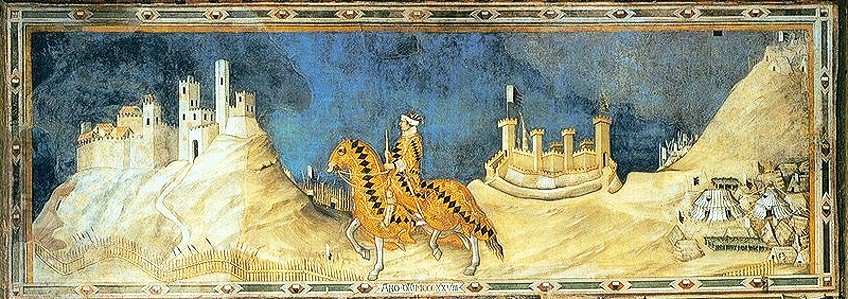
Another fresco has been uncovered on the same wall in the Sala del Mappamondo, which might confirm the argument that the fresco is not as antique as previously assumed and is not one of Martini’s works. Guidoriccio da Fogliano is seen in profile in the center of the painting, holding a Field Marshal’s baton. Montemassi may be seen on the left, encircled by walls. A siege machine with the flag of the Sienese Republic atop it stands to the right of the central figure of Guidoriccio.
A clump of tents at the base of a hill, farther to the right, is decorated with black and white pennants and flags.
Kaufmann Crucifixion (c.1360) by Unknown Artist
| Artist | Unknown (c. 1360) |
| Date | c. 1360 |
| Medium | Painting on wood |
| Location | Gemäldegalerie, Tiergarten, Mitte, Berlin, Germany |
This Bohemian Gothic panel painting was produced by an unknown artist. It was most likely the focal point of a tiny folding altarpiece. In 1918, it was refurbished and reattached on a new canvas base. It is the first known picture of Calvary in the Bohemian setting, with three crosses and a series of events underneath them, both of which allude to an Italian influence.
The use of perspectival shortening and the composition of space are likewise Italian in origin.
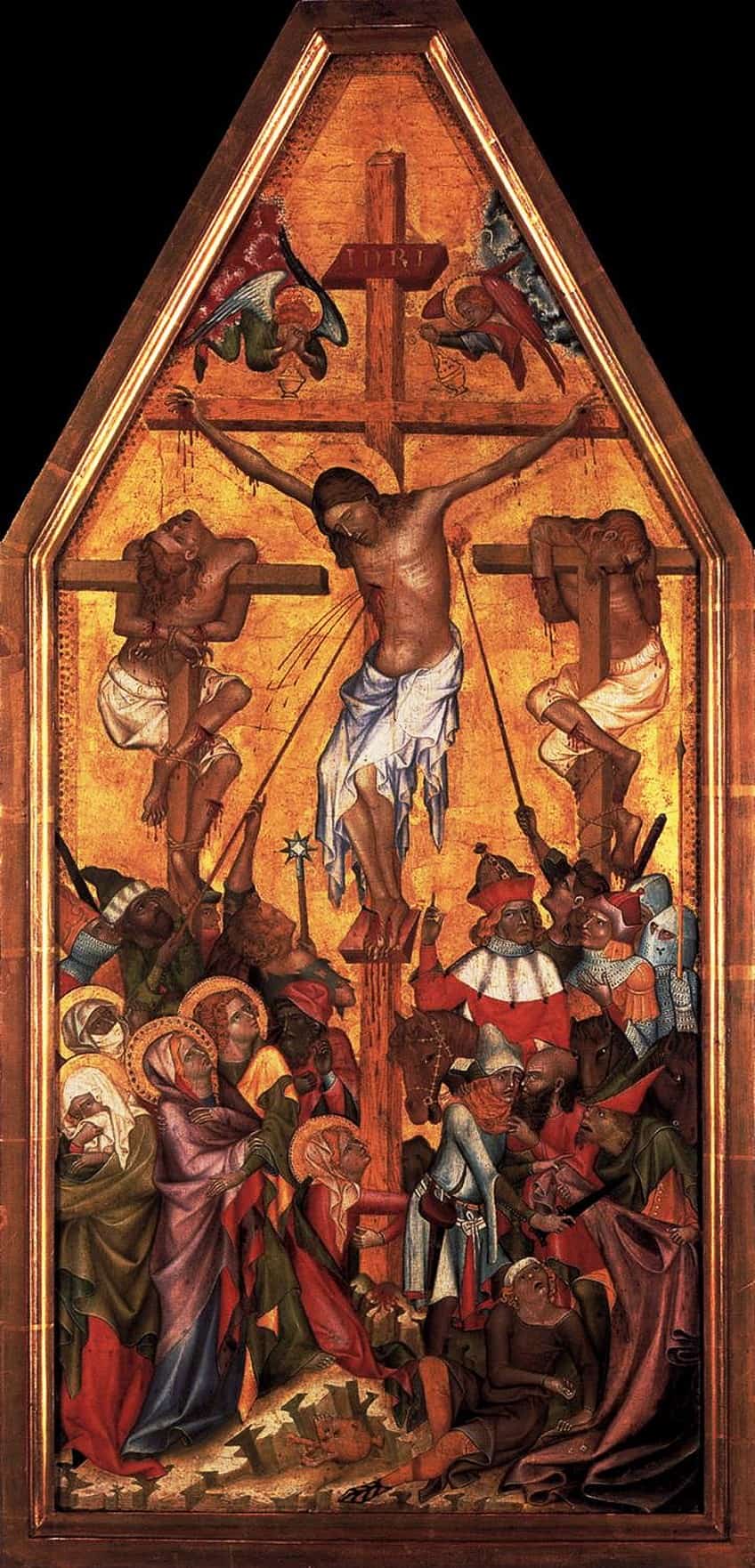
At the same time, other aspects of the painting, such as the abundance of rhythm in the movement of the figures, the precise Gothic drawings, the plastic modeling, and the Gothic vividness of color, indicate Lower Austrian and Western European models.
Třeboň Altarpiece (1380) by Master of the Třeboň Altarpiece
| Artist | Master of the Třeboň Altarpiece (c. 1350) |
| Date | 1380 |
| Medium | Panel painting |
| Location | National Galery, Prague, Czech Republic |
This is a significant piece of European Gothic-period artwork. Three wings, painted on both sides of the original huge altarpiece retable made in 1380 by an unnamed Gothic artist known as the Master of the Tebo Altarpiece, have survived. The work of art is one of the Goth artworks that contributed to the development of the International Gothic style and affected the evolution of art in a broader European setting.
The three remaining wings might have been part of a huge altarpiece that included the Crucifixion as its focal point. On the missing fourth wing, there would most likely have been a picture commemorating Christ’s Resurrection.
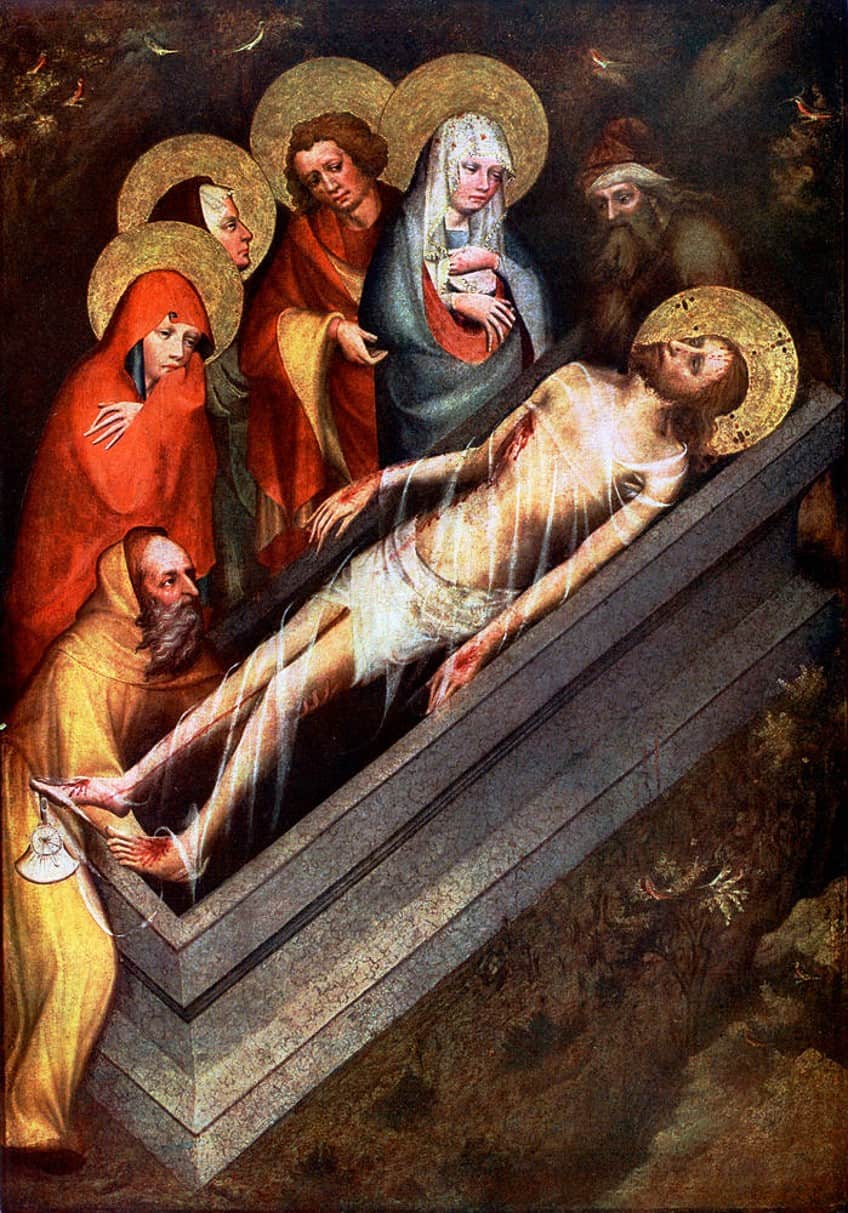
The artwork’s excellence is unparalleled, and it symbolizes the technological zenith of European Gothic artwork in the late 14th century. All of the extant panels have the same materials, painting method, and panel dimensions. The panels are made of spruce planks that are pegged together and coated on both sides with canvases. A base layer of clay and then another coating of fine chalk make up the ground. The preliminary sketch is done with a brush and iron-red pigment; the etched lines just indicate the architectural components.
The gilding is done without using an oily binder. The punched ornamentation is consistent throughout the gilt portions.
A Miracle of the Eucharist (1426) by Stefano di Giovanni
| Artist | Stefano di Giovanni (1392 – 1450) |
| Date | 1426 |
| Medium | Panel painting |
| Location | The Bowes Museum, Barnard Castle, England |
This artwork, which was previously part of the predella, or succession of pictures, on the base of a massive altarpiece, is intended to be read like a cartoon strip. The setting is a traditional 15th-century church interior. The crowd to the left is shocked at the scene happening to the composition’s right.
A young Carmelite monk was killed at the altar. His garment has become black, and the devil has taken his soul from his mouth.
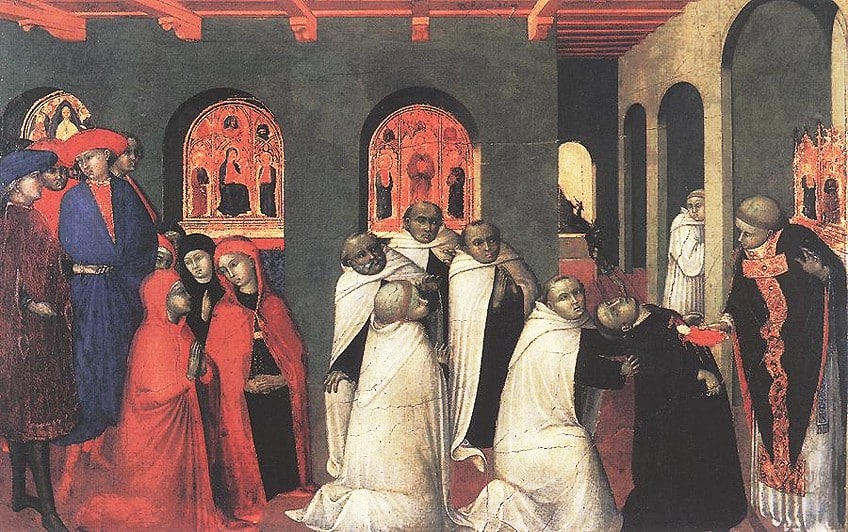
The Church taught that anybody receiving communion wine and bread at Mass must understand that they have been converted into Christ’s flesh and blood during the process. The Carmelite monk in this artwork is not a sincere believer, and as a result, he has suffered a dreadful fate.
The tableau was meant to serve as both a teaching tool and a grave warning to the assembly kneeling under the altar.
Coronation of the Virgin (1432) by Fra Angelico
| Artist | Fra Angelico (1395 – 1455) |
| Date | 1432 |
| Medium | Tempera |
| Location | The Louvre Museum, Paris, France |
Because there was a significant rise in devotion to Mary throughout the early gothic period, this Gothic artwork is a subject of Christian Art, one of the most popular themes during the 14th to the 18th centuries. Virgin Mary’s head is lowered as Christ sets the elaborate golden crown on her head.
They have divine light that represents their divinity. She is crowned in front of many influential people, with angels performing music.

From the 13th through to the 18th century and even now in Italy, this painting was a particularly famous Gothic artwork. Mary Magdalene typically wears blue clothing and has a crown of 12 stars over her head. These 12 stars on the crown signify both the 12 tribes of Israel and the number 12, which represents completeness. Blue is Mary’s associated hue since it conjures up images of the sky.
A crown made of gold was formerly a victory emblem, indicating that the wearer was triumphant in Heaven and affluent in God’s promises.
The Martyrdom of Saint Eulalia (1445) by Bernat Martorell
| Artist | Bernat Martorell (1390 – 1452) |
| Date | 1445 |
| Medium | Tempera and gold leaf on wood |
| Location | Museu Nacional d’Art de Catalunya, Barcelona, Spain |
This Gothic painting portrays the narrative of Eulalia, a 13-year-old girl from an aristocratic family living near Barcelona. During Diocletian’s persecutions, governor Dacian came to the city to implement the decrees. Eulalia later left her house, visited the city, and challenged the governor about his ruthless persecution of Christians.
Unable to disregard a young girl’s articulate arguments, Dacian immediately had Eulalia stripped practically nude and flagellated, followed by grimmer tortures that would not stop until she recognized the mistake of her ways.
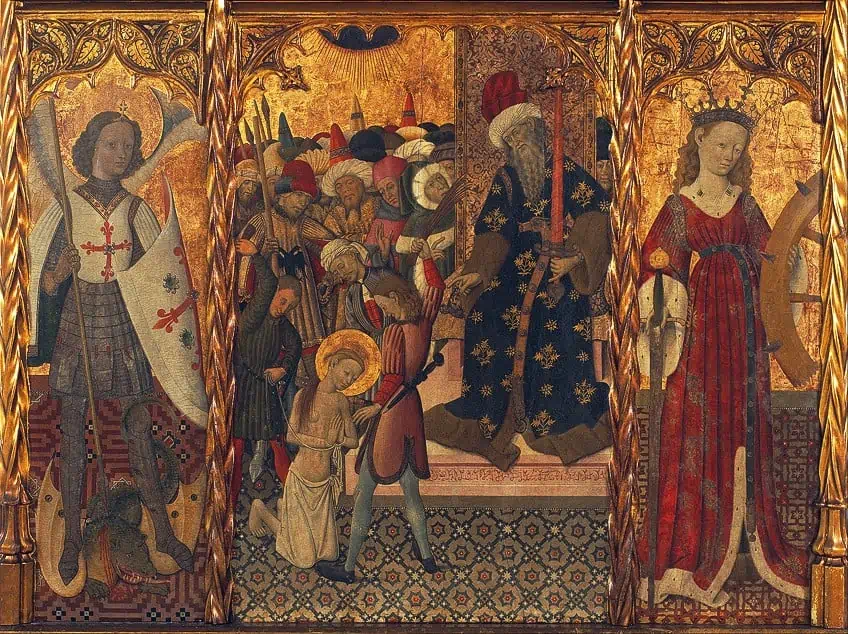
She fought till the last, pleading with God to take her to Heaven before succumbing to her wounds. Following her death, a dove is said to have flown out of her lips. Then, like a cloak, a sudden snowfall engulfed her. Her tortures are said to have concluded in her crucifixion, and she is represented with this cross as the tool of her sacrifice.
It has been suggested, though, that she was publicly executed by torture and her body was left on display, with artistic renderings of this contributing to the subsequent notion that she was crucified.
Santa Lucia de’ Magnoli Altarpiece (1447) by Domenico Veneziano
| Artist | Domenico Veneziano (1410 – 1461) |
| Date | 1447 |
| Medium | Tempera on panel |
| Location | Uffizi Gallery, Florence, Italy |
Domenico most likely painted this altarpiece in the second half of the 1440s, depicting the Mother and Child with four saints and associated legends in the predella, which is now divided among other museums. It depicts the mother and child, as well as Saints John the Baptist, Francis, Lucy, and Zenobius. The sacra conversazione is set in a thoroughly Renaissance architectural environment, where the viewpoint is enhanced by the floor’s foreshortening.
The classic frame of Gothic paintings is turned into an attractive loggia embellished with magnificent marble intarsia in the Magnoli Altarpiece. The throne, with the Madonna and Child and four saints, is protected by this structure.
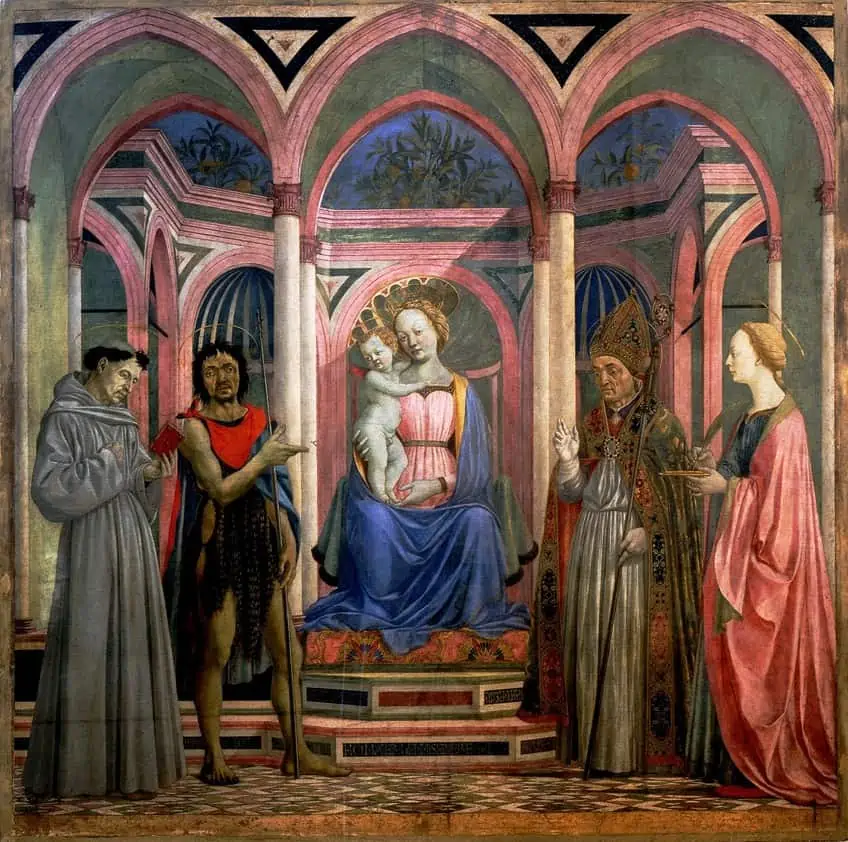
Each of these figures has his or her unique physical and moral personality, which is represented not only by the relief with which the lovely faces are created but also by the exact location they occupy inside the area so precisely delineated by the architectural framework. Castagno’s influence has been given credit for the powerful realism of St. John the Baptist and St. Francis, particularly the tormented image of St. John, but this should only be seen as a more general indication that Domenico was a painter of his time.
This was a time that was dominated by the magnificent sculpture of Donatello and Ghiberti.
Saint George Slaying the Dragon (1470) by Carlo Crivelli
| Artist | Carlo Crivelli (1435 – 1495) |
| Date | 1470 |
| Medium | Tempera and gold on panel |
| Location | Isabella Stewart Gardner Museum, Boston, United States |
Saint George Slaying the Dragon is one of Carlo Crivelli’s finest, charged with intensity and seething with spiky shapes. Even though the painter worked for more than 30 years after creating it, he never produced something nearly as vibrant and imaginative.
What could be more striking than the juxtaposition of the rising horse, its head twisted in dread, and the compassionate saint, his gaze fixated on the dragon he is going to slaughter?
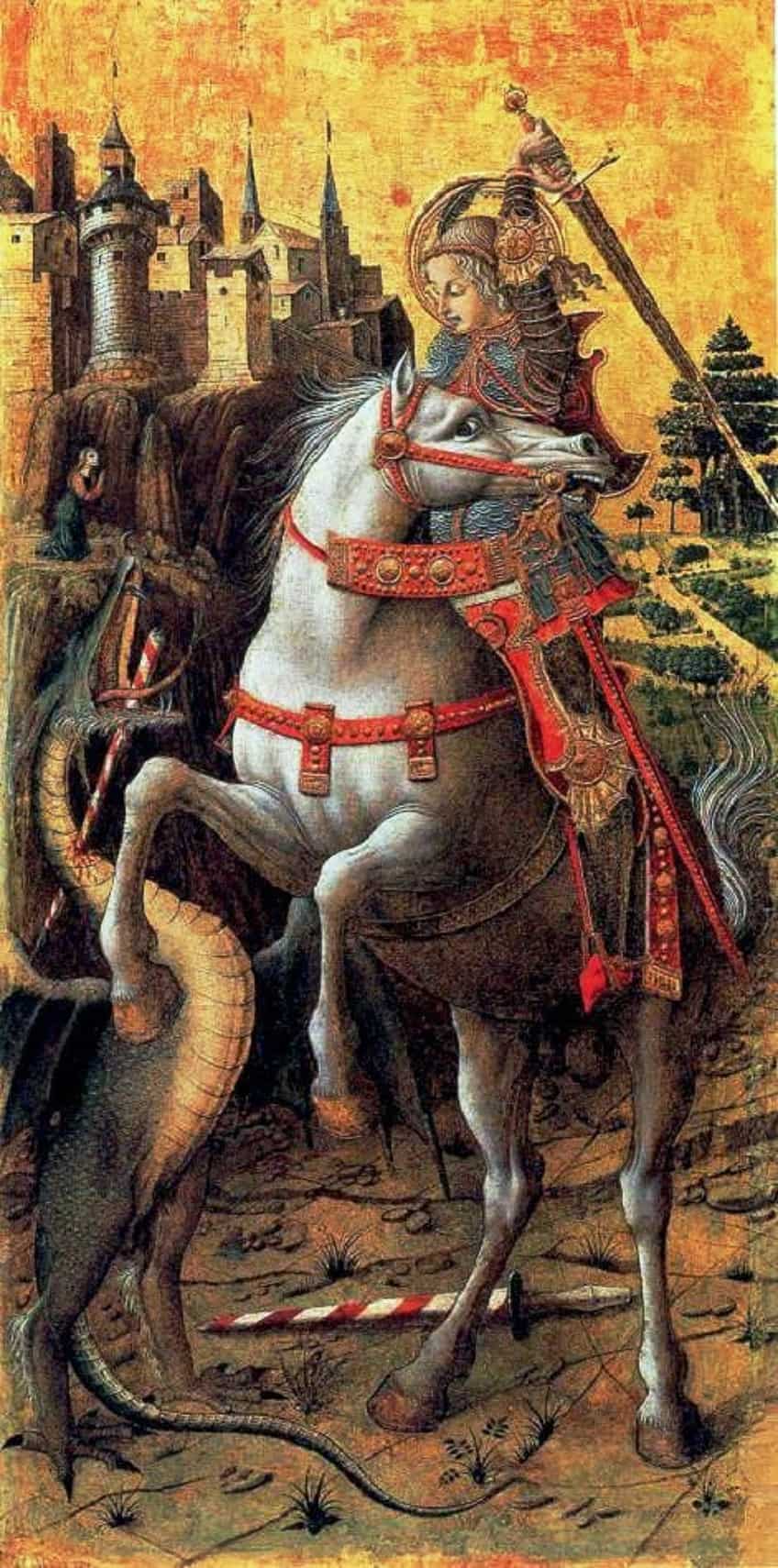
Crivelli’s hero is a thin individual who must use all of his strength to handle his hefty sword. The protruding outlines of his armor are reflected in the hill town’s towers in the distance. A little person kneels on a precipice right below it.
Crivelli condensed Saint George’s narrative, in which he protected a city and its princess from a raiding dragon, into a dramatic, powerful moment.
The monster roars in anguish as it is run through with a spear, terrifying this saint’s horse. The horse rises and backs away, his eyes wide with terror. George rises as he lowers the reins and pulls his blade to execute the deadly blow in a masterful display of horsemanship. This artwork formed the right side of the Porto San Giorgio polyptych, an uncommon topic for an altarpiece’s side panel.
We hope you enjoyed our list of famous Gothic paintings. Gothic-period art began around 1150 AD somewhere in Europe and continued until around 1440 AD in Florence. Owing to the encroaching Goths and Germanic Tribes circa 400 AD, art lost its classical significance during the Middle Ages. This art era spanned 150 years in certain parts of Europe and around 350 years in others. When creating altarpieces, artists employed tempera, an egg-based material. The panel was made with a plaster and glue combination that was occasionally strengthened with linen. Red sizing and gold leaf were applied to this, and undercoating was employed where necessary before applying color. Before the Goth artwork was finished, many thin coats of tempera were applied. Although Gothic art lacked depth, it certainly didn’t lack character, and artworks from this period are still revered – especially within religious spheres.
Take a look at our Gothic paintings webstory here!
Frequently Asked Questions
What Is Gothic Artwork?
Byzantine Gothic artworks were flat and lacked depth. Everything was articulated on the same front level by the Gothic artists, with no receding parts going backward into areas behind the figures themselves. The background was often depicted in a pure gold tone with no demarcation or atmospheric perspective.
What Are the Characteristics of Gothic Drawings?
Gothic artists started to refine and build on Gothic-period art over time. Figures grew increasingly lifelike, realistic, dynamic, emotional, and engaged with one another. Artists sought to portray their figures as dominating space and receding into the backdrop in certain circumstances. Gothic artists started to pay greater attention to nature and attempted to represent the environment more accurately.
Jordan Anthony is a Cape Town-based film photographer, curator, and arts writer. She holds a Bachelor of Art in Fine Arts from the University of the Witwatersrand, Johannesburg, where she explored themes like healing, identity, dreams, and intuitive creation in her Contemporary art practice. Jordan has collaborated with various local art institutions, including the KZNSA Gallery in Durban, the Turbine Art Fair, and the Wits Art Museum. Her photography focuses on abstract color manipulations, portraiture, candid shots, and urban landscapes. She’s intrigued by philosophy, memory, and esotericism, drawing inspiration from Surrealism, Fluxus, and ancient civilizations, as well as childhood influences and found objects. Jordan is working for artfilemagazine since 2022 and writes blog posts about art history and photography.
Learn more about Jordan Anthony and about us.
Cite this Article
Jordan, Anthony, “Famous Gothic Paintings – Explore the Top Gothic-Period Art.” artfilemagazine – Your Online Art Source. November 11, 2022. URL: https://artfilemagazine.com/famous-gothic-paintings/
Anthony, J. (2022, 11 November). Famous Gothic Paintings – Explore the Top Gothic-Period Art. artfilemagazine – Your Online Art Source. https://artfilemagazine.com/famous-gothic-paintings/
Anthony, Jordan. “Famous Gothic Paintings – Explore the Top Gothic-Period Art.” artfilemagazine – Your Online Art Source, November 11, 2022. https://artfilemagazine.com/famous-gothic-paintings/.


